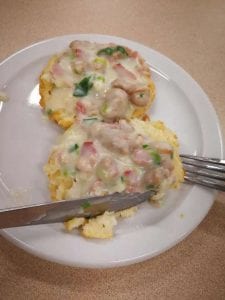For the Iron Chef project, we got the “secret ingredient”– cinnamon. At first, I thought it always matches the sweet dessert so I wanted to do a salty savory food to make our dish outstanding. I searched some recipes online, but then we found that we were lack of the ingredients to do most of the salty dishes, so we decided to do an easy, basic but interesting one– cinnamon waffle sticks. We all agree with this recipe because we like waffles and we got all the ingredients to do it. Time also influenced our decision, the waffles were quick to cook and also the dipping sauce was easy to make
We cooperated so well this time. Naomi and I made the waffles with eggs, milk, cinnamon, and flour; considering the color of the waffles, we put brown sugar in the butter to make it looks delicious. At the same time, Emily and Tyler made the maple cinnamon dipping sauce using cream, butter, and cinnamon.
At last, we finished just on time and we also plated the sticks in an interesting post. We considered all the elements that we should notice, including the temperature, the texture, the flavor, and the color. We also sprinkled the cinnamon on top of the dish make it look more pretty.
I enjoyed the ingredients preparing part and the cooking part this time because I found myself more helpful than before, I did learn a lot in food class unconsciously. I know how to use some basic machine like the waffle machines, the whisking machine the oven and I know a lot of names of the cookers such as the spatula, the leveler,(which we call “the best friend”) and the measuring cups and so on. I appreciate it so much for taking the food class this semester.
If I was to do this activity again, I would like to keep the waffles in the oven before we served, that way they could be warmer than the final product. That’s the only imperfect part during the whole lab due to the omit of time.
River Qi








